Aaron, a strong and calloused construction worker, knew the sting of hardship. The ghosts of childhood trauma and military service lingered, manifesting as crippling anxiety and depression. But Aaron wasn’t alone. By his side, ever vigilant, was his furry companion, Knucklehead – a dog with a name that perfectly captured his goofy charm and occasional bouts of stubbornness.

Their story wasn’t a fairytale one. Aaron had recently lost his previous service dog, a constant source of solace and support. The ache of that loss was fresh, a gaping hole in his life. Then, one seemingly ordinary day, fate intervened. Aaron found himself lending a helping hand to a stranded motorist, a kind woman struggling to change a tyre. As thanks, she offered him a scruffy pup nestled amongst his siblings in the back of her car. It was Knucklehead, a ball of boundless energy with eyes that held a depth beyond his years.
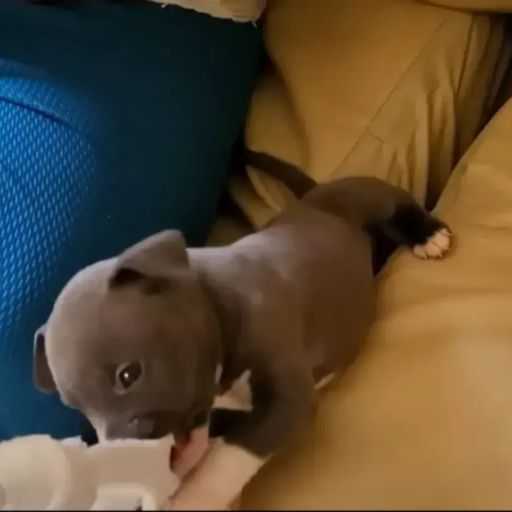
Aaron wasn’t initially sure about adopting another dog. The pain of losing his previous service dog was still raw. But there was something about Knucklehead, a spark of determination and unwavering loyalty that mirrored his own. Aaron took a leap of faith, welcoming Knucklehead into his life.
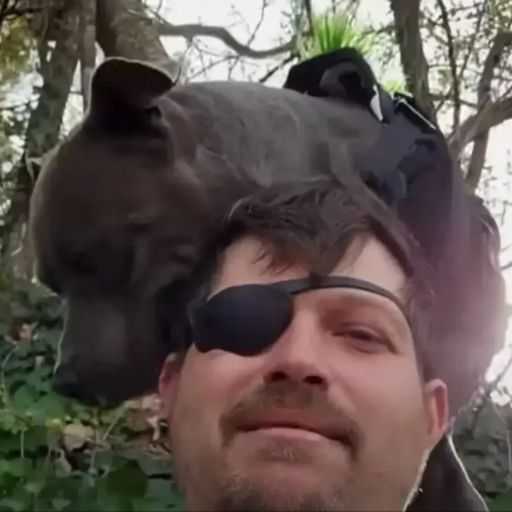
Their bond blossomed quickly. Knucklehead, despite his playful demeanour, possessed an uncanny ability to sense Aaron’s moods. When darkness threatened to engulf Aaron, a gentle nudge from Knucklehead or the comforting weight of his furry head on Aaron’s lap was enough to pull him back from the brink. Knucklehead wasn’t formally trained, but his intuition was a balm to Aaron’s troubled soul.

One particular quirk of Knucklehead’s left Aaron both bewildered and strangely touched. The dog, despite a healthy fear of heights, had developed a habit of scaling ladders to reach Aaron. There was no training involved, just Knucklehead’s unwavering desire to be by his human side, even if it meant conquering his fears. It was a testament to the strength of their connection, a silent promise of unwavering companionship.
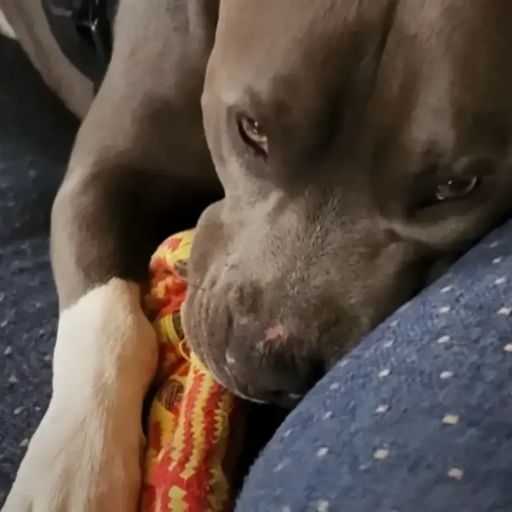
Life wasn’t without its challenges. Aaron’s PTSD reared its head sometimes, leaving him withdrawn and despondent. But Knucklehead, ever the optimist, refused to give up. He’d nudge Aaron persistently until he rose from his self-imposed exile, his wet nose nudging Aaron’s hand in a silent plea for a walk or a game of fetch. Slowly, almost imperceptibly, the fog would lift, replaced by a sliver of hope, a reminder that he wasn’t alone in his struggles.
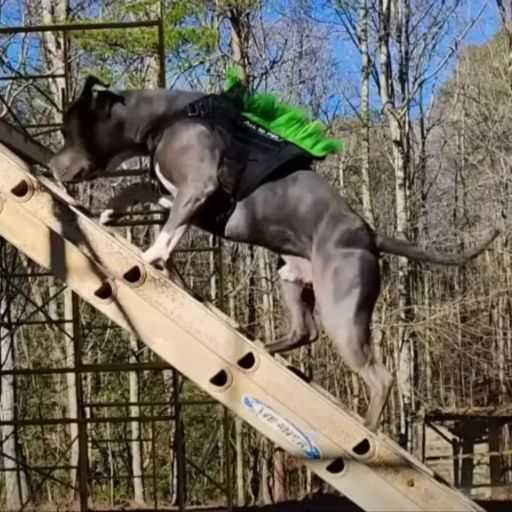
One breezy afternoon, an idea sparked in Aaron’s mind. He often found solace on his motorcycle rides, the wind whipping through his hair, the rhythmic rumble of the engine a calming counterpoint to the chaos within. But this time, a question lingered – could Knucklehead join him?
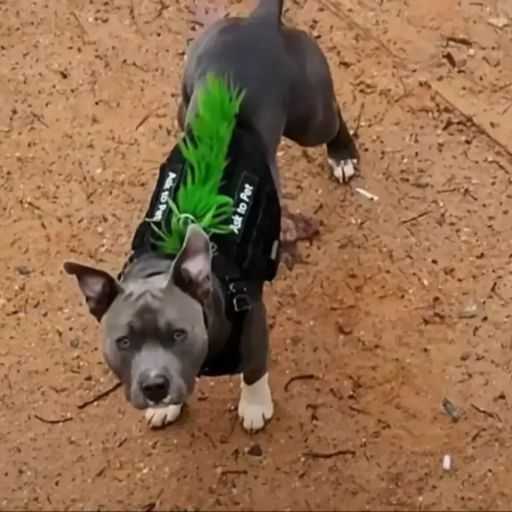
Without hesitation, Aaron strapped Knucklehead securely into a specially designed harness, his heart pounding with a mix of excitement and trepidation. To his surprise, Knucklehead took to it like a natural, his ears flapping in the wind, a goofy grin plastered on his face. As they cruised down the open road, a sense of freedom washed over Aaron. It wasn’t just the wind or the scenery; it was the feeling of companionship, of having his best friend by his side on this unexpected adventure.

Their motorcycle rides became a cherished ritual. It was a time for pure, unadulterated joy, a chance to shed their burdens and simply exist in the moment. The rumble of the engine became a shared heartbeat, a testament to their unwavering bond. Knucklehead, a furry ambassador of happiness, brought smiles to the faces of everyone they encountered on their journeys.

Aaron and Knucklehead’s story wasn’t about grand gestures or overcoming insurmountable odds. It was about the quiet strength found in companionship, the unwavering loyalty that can blossom between a man and his dog. It was a testament to the healing power of love, acceptance, and the simple act of sharing the open road with a friend. In the vastness of the world, they had found solace in each other, two souls forever bound by an invisible thread, stronger than steel, softer than a gentle breeze.
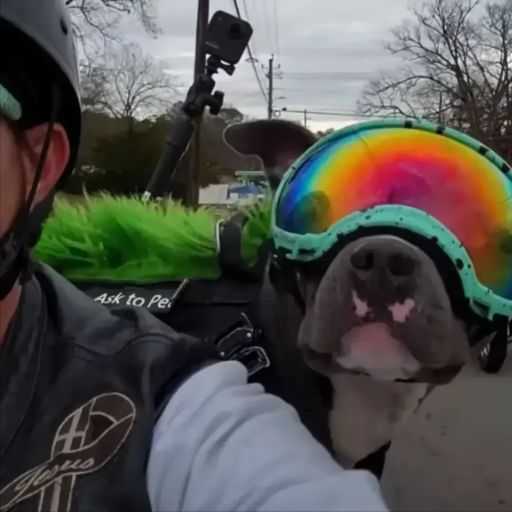
Watch The Full Video Here:
If you’ve ever found yourself wondering about the quirks of your furry best friend, the mystery of whether dogs have belly buttons might have crossed your mind. As a seasoned dog enthusiast, you’re constantly discovering new things about your canine companion. The topic of belly buttons in dogs may seem straightforward, but the answer might surprise you. Your bond with your pup grows stronger with each shared moment, making you curious about every little detail, even the ones hidden beneath their fur. Let’s embark on a journey to unravel the secrets behind this intriguing aspect of our beloved four-legged pals.
Exploring the Anatomy of Dogs
In understanding whether dogs have belly buttons, it’s essential to delve into the anatomy of our furry companions. Dogs do have belly buttons, but they may look different from human belly buttons. This is because a dog’s umbilical cord falls off shortly after birth, leaving behind a scar that is flat and often covered by fur.
- Belly Button Appearance: A dog’s belly button may appear as a small depression or an area with slightly different pigmentation compared to the surrounding skin. It’s usually not as prominent as a human belly button but can still be observed with a closer look.
- Function: While a dog’s belly button doesn’t serve the same purpose as a human belly button, it marks the spot where the umbilical cord once connected the puppy to its mother’s placenta in the womb. Once the umbilical cord detaches, the belly button remains as a reminder of a dog’s early development.
- Importance of Belly Buttons: Although a dog’s belly button may not have a significant purpose after birth, it’s a unique feature that showcases the miracle of life and the bond between a mother dog and her puppies during the gestation period.
- Caring for Your Dog’s Belly Button: It’s important to keep an eye on your dog’s belly button area to ensure there are no signs of infection or irritation. If you notice any redness, swelling, or discharge, consult your veterinarian for proper guidance on how to care for it.
Understanding the anatomy of dogs, including their belly buttons, can deepen your connection with your canine companion and give you a deeper appreciation for the wonders of nature.
Investigating Dog’s Abdominal Region
When checking your dog’s belly button, you might notice a small depression or a pigmented area. This mark serves as a reminder of your dog’s early connection to their mother’s placenta in the womb. While not the same as a human belly button, it’s a unique feature worth appreciating.
Monitoring this area is essential to ensure there are no signs of infection. Keeping an eye on your dog’s belly button can help maintain their overall health and well-being. The belly button is a reminder of their origin and the incredible bond between a mother dog and her puppies.
Understanding the anatomy of your furry friend, including their belly button, can deepen your bond with them. It’s a simple yet fascinating aspect of your dog’s development that highlights the wonders of nature and the unique journey of a dog from birth to your loyal companion.
Addressing Common Misconceptions
When it comes to dogs and their belly buttons, there are some common misconceptions that need clarification. Let’s tackle these to provide a better understanding:
1. Absence of Belly Button:
Contrary to popular belief, dogs do have belly buttons. These belly buttons are small and subtle, often covered by fur. They may not be as prominent as human belly buttons, but they do exist.
2. Functionality of Belly Buttons:
While a dog’s belly button isn’t as crucial as it is for humans, it serves as a reminder of their connection to their mother in the womb. It’s a remnant of their time in utero and marks the spot where the umbilical cord once attached.
3. Variability in Appearance:
The appearance of a dog’s belly button can vary based on breed and individual characteristics. Some may have a more visible scar, while others may have a lightly pigmented area or a small depression.
4. Importance of Monitoring:
Keeping an eye on your dog’s belly button area is essential for their well-being. Any changes in appearance, redness, discharge, or unusual behavior around this area should prompt a visit to the vet.
5. Myth Busting:
Dispelling the myth that dogs don’t have belly buttons is essential to understanding and appreciating this unique aspect of their anatomy. Embracing this fact enriches your bond with your furry companion.
Clearing up these misconceptions helps you appreciate the subtleties of your dog’s anatomy and strengthens your connection with your loyal canine friend.
Research Findings and Expert Opinions
When it comes to the topic of whether dogs have belly buttons, the consensus among experts is clear. While dogs do have belly buttons, they are quite different from those of humans. A dog’s belly button is typically a small, flat scar that may be covered by fur, making it less noticeable than a human belly button. It serves as a reminder of the vital connection between a mother and her pups during pregnancy.
Experts emphasize that a dog’s belly button is a natural feature that appears where the umbilical cord was attached in the womb. The appearance of a dog’s belly button can vary based on factors such as breed and individual characteristics, so it may not be prominent in all dogs. However, it remains an important anatomical marker that reflects a dog’s journey from prenatal development to birth.
Monitoring your dog’s belly button area is essential for detecting any signs of infection or unusual changes. If you notice redness, swelling, discharge, or any other concerning symptoms around this area, it’s recommended to consult a veterinarian promptly. Maintaining good hygiene and regular vet check-ups can help keep your dog healthy and happy.
Understanding that dogs indeed have belly buttons, albeit different from humans, adds to the appreciation of the bond between you and your furry companion. By staying informed about this aspect of your dog’s anatomy, you can ensure their well-being and strengthen your connection with them.
Conclusion
So, there you have it – dogs do indeed have belly buttons! These tiny scars, often hidden under fur, serve as a sweet reminder of their time in the womb. Remember, keeping an eye on your pup’s belly button can help you catch any issues early on. Each dog’s belly button is unique, just like your furry friend! Embrace this special part of their anatomy and show them some extra love and care. Strengthen your bond by appreciating this little detail that connects your dog to their past. Keep your pup happy and healthy by being mindful of this small but significant feature.
Frequently Asked Questions
Do dogs have belly buttons?
Yes, dogs do have belly buttons. They are small scars typically covered by fur, marking the spot where the umbilical cord was attached in the womb.
Why is it important to monitor a dog’s belly button?
Monitoring a dog’s belly button is crucial for detecting any signs of infection or changes that may indicate underlying health issues.
How does the appearance of a dog’s belly button vary?
The appearance of a dog’s belly button can vary based on the breed and individual characteristics of the dog.
What purpose does a dog’s belly button serve?
A dog’s belly button serves as a reminder of their connection to their mother in the womb and is a natural feature where the umbilical cord was attached.

Hey there, I’m Janet Brooks, a dog-loving student from California. I’m all about helping pups in need, especially those without homes. Me and my awesome friends work together to give shelter and love to stray dogs. Oh, and I also write blogs about dogs to share helpful info.